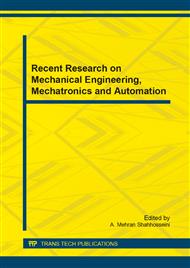[1]
H.P. Du, K.Y. Sze,J. Lam, Semi-active H-infinity control of vehicle suspension with magneto-rheological dampers. J. Sound Vibr. 283(3-5) 981-996.
DOI: 10.1016/j.jsv.2004.05.030
Google Scholar
[2]
Y.K. Lau W.H. Liao, Design and analysis of magnetorheological dampers for train suspension. Proc. Inst. Mech. Eng. Part F-J. Rail Rapid Transit. 219(4) 261-276.
DOI: 10.1243/095440905x8899
Google Scholar
[3]
D.C. Batterbee, N.D. Sims, R. Stanway, et al., Magnetorheological landing gear: 1. A design methodology. Smart Mater. Struct. 16(6) 2429-2440.
DOI: 10.1088/0964-1726/16/6/046
Google Scholar
[4]
D.C. Batterbee, N.D. Sims, R. Stanway, et al., Magnetorheological landing gear: 2. Validation using experimental data. Smart Mater. Struct. 16(6) 2441-2452.
DOI: 10.1088/0964-1726/16/6/047
Google Scholar
[5]
W. Hu, N.M. Wereley, L. Chemouni, et al., Semi-active linear stroke magnetorheological fluid-elastic helicopter lag damper. J. Guid. Control Dyn. 30(2) 565-575.
DOI: 10.2514/1.24033
Google Scholar
[6]
G.J. Hiemenz, W. Hu,N.M. Wereley, Semi-active magnetorheological helicopter crew seat suspension for vibration isolation. J. Aircr. 45(3) 945-953.
DOI: 10.2514/1.32736
Google Scholar
[7]
G. Yang, B.F. Spencer, J.D. Carlson, et al., Large-scale MR fluid dampers: modeling and dynamic performance considerations. Eng. Struct. 24(3) 309-323.
DOI: 10.1016/s0141-0296(01)00097-9
Google Scholar
[8]
H.S. Hu, X.Z. Jiang, J. Wang, et al., Design, modeling, and controlling of a large-scale magnetorheological shock absorber under high impact load. J. Intell. Mater. Syst. Struct. 23(6) 635-645.
DOI: 10.1177/1045389x12436727
Google Scholar
[9]
Z.C. Li,J. Wang, A gun recoil system employing a magnetorheological fluid damper. Smart Materials and Structures. 21(10) 105003-105012.
DOI: 10.1088/0964-1726/21/10/105003
Google Scholar
[10]
H.U. Oh,J. Onoda, An experimental study of a semiactive magneto-rheological fluid variable damper for vibration suppression of truss structures. Smart Mater. Struct. 11(1) 156-162.
DOI: 10.1088/0964-1726/11/1/318
Google Scholar
[11]
H.U. Oh, Experimental demonstration of an improved magneto-rheological fluid damper for suppression of vibration of a space flexible structure. Smart Mater. Struct. 13(5) 1238-1244.
DOI: 10.1088/0964-1726/13/5/028
Google Scholar
[12]
A. Dominguez, R. Sedaghati,I. Stiharu, Semi-active vibration control of adaptive structures using magnetorheological dampers. Aiaa J. 44(7) 1563-1571.
DOI: 10.2514/1.18402
Google Scholar
[13]
A. Dominguez, R. Sedaghati,I. Stiharu, Modeling and application of MR dampers in semi-adaptive structures. Comput. Struct. 86(3-5) 407-415.
DOI: 10.1016/j.compstruc.2007.02.010
Google Scholar
[14]
L.S. Huo, G.B. Song, S. Nagarajaiah, et al., Semi-active vibration suppression of a space truss structure using a fault tolerant controller. J. Vib. Control. 18(10) 1436-1453.
DOI: 10.1177/1077546311421514
Google Scholar
[15]
D. Wang,W. -H. Liao, Magnetorheological fluid dampers: a review of parametric modelling. Smart Mater. Struct. 20(2) 023001-023035.
DOI: 10.1088/0964-1726/20/2/023001
Google Scholar
[16]
N.M. Kwok, Q.P. Ha, T.H. Nguyen, et al., A novel hysteretic model for magnetorheological fluid dampers and parameter identification using particle swarm optimization. Sens. Actuator A-Phys. 132(2) 441-451.
DOI: 10.1016/j.sna.2006.03.015
Google Scholar


